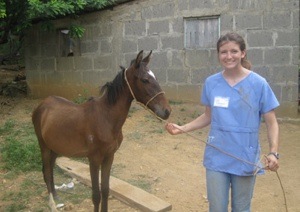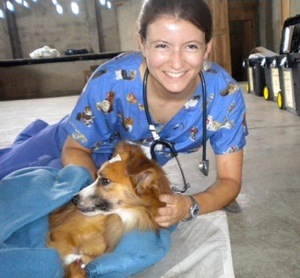
Morning: We usually met together as a group at 7am on clinic days, and 7:30 or 8am on non-clinic days. The other two girls I was rooming with (there were usually three of us in a room) and I would get up, take a (usually cold) shower, and go down to breakfast. The breakfasts were usually provided by the hotel (no additional charge). Black beans and rice with fruit (often pineapple and watermelon) was the typical breakfast, although we did get occasional pancakes, eggs, and various types of meat. On clinic days, we would ride together in a bus to the clinic location after breakfast. We would set up the clinics at various locations, including a church, a school, and private property. We would start taking patients around 8am.
Afternoon: If we were at a clinic, lunch would be provided and everyone would rotate to get food. We would then continue taking patients. Working in pairs, we would do a full exam of every animal we were given. Then, we would prepare the animal for surgery (if it was to be spayed or neutered), including giving injections, setting catheters, and intubating. One person in each pair would become sterile and assist with the surgery, while the other monitored the animal under anesthesia. After the surgery, we stayed with our animal until it had recovered from the anesthesia. We also did other things, such as clean their ears, spray for fleas/ticks, trim nails, inject dewormer, and prepare take-home medications. Professionals were always available to help and make sure every animal was cared for properly, but we got a lot of hands-on experience. A clinic day usually ended around 4pm.

Evening: Our evenings were usually free, although we sometimes had scheduled activities. We were generally responsible for our own dinner, and could either eat at the hotel or walk in a group to a nearby restaurant. Evening activities included a dance class, soccer, swimming in the pool. They pretty much let us have free reign, as long as we stayed in groups and were not out too late the night before a clinic.
Highlights: The highlight of my volunteer experience was the clinic day that we spent doing livestock. I want to become a livestock veterinarian, so I particularly loved working with the horses, cattle, pigs, and goats. Most of the other clinic days, we saw about 95% dogs and only a few cats. On the livestock day, we mainly gave vitamin injections and dewormer, but restraining the animals for these tasks was very interesting.
The highlight of my entire experience was the time we spent with homestay families. We got to practice our Spanish, exchange pictures of our families, and really get a feel for the Nicaraguan culture. The families also fixed us our breakfasts and dinners, which was very nice. Each family got a pair of volunteers, so we were not alone there. Then, after the few days that we spent with our homestay family, we had a gift exchange and a potluck with all of the families, which included live music on native instruments. It was a wonderful experience.